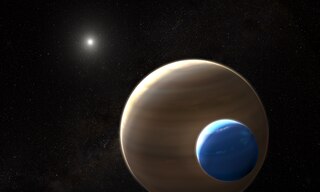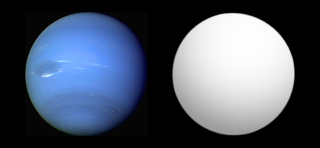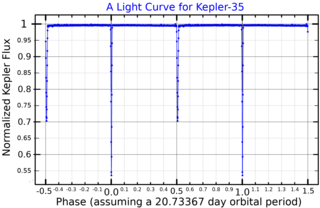Related Research Articles

An exomoon or extrasolar moon is a natural satellite that orbits an exoplanet or other non-stellar extrasolar body.

Kepler-4b, initially known as KOI 7.01, is an extrasolar planet first detected as a transit by the Kepler spacecraft. Its radius and mass are similar to that of Neptune; however, due to its proximity to its host star, it is substantially hotter than any planet in the Solar System. The planet's discovery was announced on January 4, 2010, in Washington, D.C., along with four other planets that were initially detected by the Kepler spacecraft and subsequently confirmed by telescopes at the W.M. Keck Observatory.

Kepler-7 is a star located in the constellation Lyra in the field of view of the Kepler Mission, a NASA operation in search of Earth-like planets. It is home to the fourth of the first five planets that Kepler discovered; this planet, a Jupiter-size gas giant named Kepler-7b, is as light as styrofoam. The star itself is more massive than the Sun, and is nearly twice the Sun's radius. It is also slightly metal-rich, a major factor in the formation of planetary systems. Kepler-7's planet was presented on January 4, 2010 at a meeting of the American Astronomical Society.
HAT-P-33 is a late-F dwarf star. It is orbited by a planet called HAT-P-33b. A search for a binary companion star using adaptive optics at the MMT Observatory was negative.
Kepler-17 is a main-sequence yellow dwarf star that is much more active than the Sun with starspots covering roughly 6% of its surface. Starspots are long-lived, with at least one persisting for 1400 days.

Kepler-35 is a binary star system in the constellation of Cygnus. These stars, called Kepler-35A and Kepler-35B have masses of 89% and 81% solar masses respectively, and both are assumed to be of spectral class G. They are separated by 0.176 AU, and complete an eccentric orbit around a common center of mass every 20.73 days.

PH2, also known as Kepler-86, or KIC 12735740, is a G-type star 1,120 light-years distant within the constellation Cygnus. Roughly the size and temperature of the Sun, PH2 gained prominence when it was known to be the host of one of 42 planet candidates detected by the Planet Hunters citizen science project in its second data release. The candidate orbiting around PH2, known as PH2b, had been determined to have a spurious detection probability of only 0.08%, thus effectively confirming its existence as a planet.
Kepler-65 is a subgiant star slightly more massive than the Sun and has at least four planets.
Kepler-88 is a G-type star 1,230 light-years away in the constellation of Lyra, with three confirmed exoplanets. SIMBAD lists a subgiant spectral type of G8IV, while other sources give it a main sequence spectral type of G6V. The latter is more consistent with its properties.

Kepler-25 is a star in the northern constellation of Lyra. It is slightly larger and more massive than the Sun, with a luminosity 21⁄2 times that of the Sun. With an apparent visual magnitude of 10.6, this star is too faint to be seen with the naked eye.
Kepler-61 is a K-type main-sequence star approximately 1,100 light years from Earth in the constellation Cygnus. It is located within the field of vision of the Kepler spacecraft, the satellite that NASA's Kepler Mission used to detect planets that may be transiting their stars. On April 24, 2013 it was announced that the star has an extrasolar planet orbiting in the inner edge of the habitable zone, named Kepler-61b.

Kepler-138, also known as KOI-314, is a red dwarf located in the constellation Lyra, 219 light years from Earth. It is located within the field of vision of the Kepler spacecraft, the satellite that NASA's Kepler Mission used to detect planets transiting their stars.
Kepler-30 is a star in the northern constellation of Lyra. It is located at the celestial coordinates: Right Ascension 19h 01m 08.0747s Declination +38° 56′ 50.219″. With an apparent visual magnitude of 15.5, this star is too faint to be seen with the naked eye. Kepler-30 is exhibiting a strong starspot activity.
Kepler-29 is a Sun-like star in the northern constellation of Cygnus. It is located at the celestial coordinates: Right Ascension 19h 53m 23.6020s, Declination +47° 29′ 28.436″. With an apparent visual magnitude of 15.456, this star is too faint to be seen with the naked eye. It is a solar analog, having a close mass, radius, and temperature as the Sun. Currently the age of the star has not been determined due to its 2780 light-year distance. As of 2016 no Jovian exoplanets of 0.9–1.4 MJ have been found at a distance of 5 AU.
K2-3, also known as EPIC 201367065, is a red dwarf star with three known planets. It is on the borderline of being a late orange dwarf/K-type star, but because of its temperature, it is classified as a red dwarf.
Kepler-419c is a super-Jupiter exoplanet orbiting within the habitable zone of the star Kepler-419, the outermost of two such planets discovered by NASA's Kepler spacecraft. It is located about 3,400 light-years from Earth in the constellation Cygnus. The exoplanet was found by using the transit timing variation method, in which the variations of transit data from an exoplanet are studied to reveal a more distant companion.
Kepler-1229 is a red dwarf star located about 870 light-years (270 pc) away from the Earth in the constellation of Cygnus. It is known to host a super-Earth exoplanet within its habitable zone, Kepler-1229b, which was discovered in 2016.
Kepler-419b is a hot Jupiter exoplanet orbiting the star Kepler-419, the outermost of two such planets discovered by NASA's Kepler spacecraft. It is located about 3,400 light-years (1040 parsecs from Earth in the constellation Cygnus.
Kepler-1625 is a 14th-magnitude solar-mass star located in the constellation of Cygnus approximately 7,200 light-years away. Its mass is within 5% of that of the Sun, but its radius is approximately 70% larger reflecting its more evolved state. A candidate gas giant exoplanet was detected by the Kepler Mission around the star in 2015, which was later validated as a real planet to >99% confidence in 2016. In 2018, the Hunt for Exomoons with Kepler project reported evidence for a Neptune-sized exomoon around this planet, based on observations from NASA’s Kepler mission and the Hubble Space Telescope. Subsequently, the evidence for and reality of this exomoon candidate has been subject to debate.
Kepler-1625b is a super-Jupiter exoplanet orbiting the Sun-like star Kepler-1625 about 2,500 parsecs away in the constellation of Cygnus. The large gas giant is approximately the same radius as Jupiter, and orbits its star every 287.4 days. In 2017, hints of a Neptune-sized exomoon in orbit of the planet was found using photometric observations collected by the Kepler Mission. Further evidence for a Neptunian moon was found the following year using the Hubble Space Telescope, where two independent lines of evidence constrained the mass and radius to be Neptune-like. The mass-signature has been independently recovered by two other teams. However, the radius-signature was independently recovered by one of the teams but not the other. The original discovery team later showed that this latter study appears affected by systematic error sources that may influence their findings.
References
- 1 2 3 4 5 Vallenari, A.; et al. (Gaia collaboration) (2023). "Gaia Data Release 3. Summary of the content and survey properties". Astronomy and Astrophysics. 674: A1. arXiv: 2208.00211 . Bibcode:2023A&A...674A...1G. doi: 10.1051/0004-6361/202243940 . S2CID 244398875. Gaia DR3 record for this source at VizieR.
- 1 2 Henden, A. A.; et al. (2016). "VizieR Online Data Catalog: AAVSO Photometric All Sky Survey (APASS) DR9 (Henden+, 2016)". VizieR On-line Data Catalog: II/336. Originally Published in: 2015AAS...22533616H. 2336. Bibcode:2016yCat.2336....0H. Vizier catalog entry
- 1 2 3 4 5 6 7 8 9 10 Dawson, Rebekah I.; et al. (2014). "Large eccentricity, low mutual inclination: The three-dimensional architecture of a hierarchical system of giant planets". The Astrophysical Journal. 791 (2). 89. arXiv: 1405.5229 . Bibcode: 2014ApJ...791...89D . doi: 10.1088/0004-637X/791/2/89 .
- 1 2 3 Dawson, Rebekah I.; et al. (2012). "The Photoeccentric Effect and Proto-hot Jupiters. II. KOI-1474.01, a Candidate Eccentric Planet Perturbed by an Unseen Companion". The Astrophysical Journal. 761 (2). 163. arXiv: 1206.5579 . Bibcode: 2012ApJ...761..163D . doi: 10.1088/0004-637X/761/2/163 .
- ↑ McQuillan, A.; Mazeh, T.; Aigrain, S. (2013). "Stellar Rotation Periods of The Kepler objects of Interest: A Dearth of Close-In Planets Around Fast Rotators". The Astrophysical Journal Letters. 775 (1). L11. arXiv: 1308.1845 . Bibcode: 2013ApJ...775L..11M . doi: 10.1088/2041-8205/775/1/L11 .
- ↑ "Kepler-419". SIMBAD . Centre de données astronomiques de Strasbourg . Retrieved 2019-01-24.
- ↑ Hessman, F. V.; Dhillon, V. S.; Winget, D. E.; Schreiber, M. R.; Horne, K.; Marsh, T. R.; Guenther, E.; Schwope, A.; Heber, U. (2010). "On the naming convention used for multiple star systems and extrasolar planets". arXiv: 1012.0707 [astro-ph.SR].
- ↑ Fraser Cain (16 September 2008). "How Old is the Sun?". Universe Today . Retrieved 19 February 2011.
- ↑ Fraser Cain (15 September 2008). "Temperature of the Sun". Universe Today. Retrieved 19 February 2011.
- ↑ Almenara, J. M.; et al. (2018). "SOPHIE velocimetry of Kepler transit candidates. XVIII. Radial velocity confirmation, absolute masses and radii, and origin of the Kepler-419 multiplanetary system". Astronomy and Astrophysics. 615. A90. arXiv: 1804.01869 . Bibcode: 2018A&A...615A..90A . doi: 10.1051/0004-6361/201732500 .
- ↑ Kepler 419 hpcf.upr.edu
